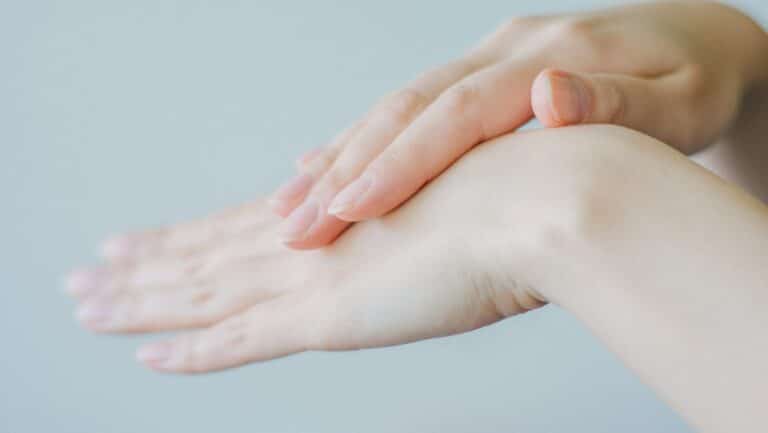Dermatitis is a broad term used to describe swelling or irritation of the skin. When this swelling is triggered by an allergic reaction that causes fluid to build up in the skin, it is called spongiotic dermatitis.1
What Is Spongiotic Dermatitis?
Spongiotic dermatitis is an ailment of the skin that may occur on its own or in conjunction with other skin conditions such as eczema, other types of dermatitis, and even diaper rash. It may appear in one spot on the body or spread to cover the entire surface of the skin, even in the pubic area and under the hair on your head. 2
What Causes Spongiotic Dermatitis?
Spongiotic dermatitis is often the result of other problems with the skin. Whatever triggers the other skin problems is also a factor in the spongiotic dermatitis. Some common causes of spongiotic dermatitis include:
- Allergic reactions – this may include reactions to bug bites, food, or medication
- Coming in contact with irritants – this includes certain chemicals that may be found in soap or lotions, some metals found in jewelry, latex, and some ingredients found in cosmetics3
- Changes in hormone levels – this may happen during puberty, pregnancy, or menopause
- Increased stress – it is thought that this happens because stress can weaken your immune system, leaving your skin with less protection
- Certain fungal infections 4
- Either excessively dry or humid air
- Changes in the weather5
Spongiotic Dermatitis Symptom Checker
Many of the symptoms of spongiotic dermatitis are similar to, or the same as, the symptoms associated with other skin problems. The doctor will likely perform a biopsy to determine what has caused your symptoms and whether you have spongiotic dermatitis or some other problem.6
During the biopsy, the doctor will cut off a very small piece of the affected skin. This skin sample is then sent to the lab for testing to determine the cause of the irritation. Look for the following symptoms to figure out whether you should go to the doctor for testing to see if you have spongiotic dermatitis.
Excessively Dry Skin
Most people experience dry skin from time to time, especially as they age. However, if your dry skin is scaly, red, and irritated and topical lotions don’t help or make it worse, it may be time to schedule a visit with a dermatologist. This dry skin may appear in patches, appear in matching places on appendages, like the backs of both hands or elbows, or be widespread across the whole body.
Excessive Itching
Some itching is a normal part of everyone’s life. If yours is intense enough to keep you awake at night or is constant and distracts you from your daily life, seek professional advice.
Rashes
Rashes in the crook of the elbows, the palms of the hands, and behind the knees are associated with spongiotic dermatitis. If you have rashes that itch and ooze in these places or elsewhere, it is time to see your dermatologist.
Red Skin
Large patches of reddened skin that cannot be explained by the temperature or other factors may be caused by spongiotic dermatitis. These red areas may be but aren’t always swollen and itchy.
Dandruff
Not all dandruff is caused by spongiotic dermatitis, but if you’re using medicated shampoo and it isn’t working, or the flakes are large, and your scalp feels crusty, it may be the cause.7
Any Combination of the Above Symptoms
While even one of the above-listed symptoms may mean that you have spongiotic dermatitis, a combination makes the diagnosis more likely.
Treatments for Spongiotic Dermatitis
There is no treatment specifically for spongiotic dermatitis. You can try to find the underlying causes and treat them. It is also helpful to determine what triggers flare-ups so you can take steps to avoid them.
Treatments for Underlying Conditions
If eczema is the root cause of your spongiotic dermatitis, you can try the following remedies to ease the symptoms of it8:
- Topical cortisone creams
- A thin layer of petroleum jelly over the affected areas
- Bleach baths – these should only be done when recommended by your doctor and by following their instructions carefully
If another type of dermatitis is the underlying cause, you can try frequent hair washings with shampoos containing zinc pyrithione, ketoconazole, or selenium.9
Lifestyle Changes That May Help
The above treatments may be helpful once a flare-up has begun, but with a few lifestyle changes, you may be able to keep them from happening at all.10
- Avoid soaps, detergents, and shower gels – some find success showering with body lotions
- Take antihistamines – these block the production of histamines when you come into contact with an allergen. If allergic reactions are causing your flare-ups, antihistamines should prevent them
- Wear bandages or wraps over affected areas to prevent scratching
- Spend time in the sunshine or start phototherapy
- Take oral steroids – these are not without side effects and should not be taken long term, but they may help to control nasty flare-ups
Want to Learn More?
If you want to learn more about spongiotic dermatitis or any other skin condition, visit myskintreatment.com.
SOURCES:
- MedicalNewsToday.com: ” What Is Spongiotic Dermatitis?”
- Healthline.com: ” Spongiotic Dermatitis: Causes, Symptoms, and Treatment.”
- Healthline.com: ” Spongiotic Dermatitis: Causes, Symptoms, and Treatment.”
- MyPathologyReport.ca: “Spongiotic Dermatitis”
- MedicalNewsToday.com: ” What Is Spongiotic Dermatitis?”
- Healthline.com: ” Spongiotic Dermatitis: Causes, Symptoms, and Treatment.”
- Healthline.com: “Spongiotic Dermatitis: Causes, Symptoms, and Treatment.”
- Healthline.com: ” Spongiotic Dermatitis: Causes, Symptoms, and Treatment.”
- MyPathologyReport.ca: “Spongiotic Dermatitis”
- MedicalNewsToday.com: ” What Is Spongiotic Dermatitis?”






